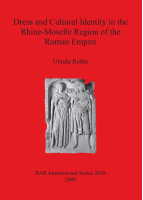Description
BOOK DESCRIPTIONWhile the present inquiry charts new territory in Roman cultural research, there are in fact two academic disciplines that have long recognised the relationship between clothing and identity and have established useful theoretical frameworks in which to examine this relationship: anthropology and sociology. Following the introduction, chapter 2 begins with a discussion of the symbolic meanings of dress as identified by sociologists and anthropologists based on their research in more modern contexts. Thenext two sections set out the chronological and geographical scope of the study by explaining the time period chosen and the boundaries and histories of the study's three areas. This investigation is primarily focussed on depictions on grave monuments. The reasons for this, as well as a discussion of the nature of the sources and their unique potential to inform us about identity, are the subject of chapter 3. More technical aspects of the use of Roman gravestones are included in Appendix III. In order to be able to gauge the effect integration into the Roman Empire had on the dress behaviour of the Rhine-Moselle population, it is important first to establish what was worn in the region before Roman conquest. This is closely linked to the question of the origins of the garments found in the Roman period. The first part of chapter 4 puts forward a number of new theories regarding pre-Roman dress in the region and the origins of garments. As a result, and also due to a certain amount of confusion in terminology in previous studies, the second part of chapter 4 presents a typology of garments including brief descriptions. Each garment is given a code number to facilitate identification in the catalogue which includes all civilian funerary monuments depicting identifiable clothing from the Rhine-Moselle region. Chapter 5 discusses the results from analysing dress behaviour on the stones in the catalogue which is presented, primarily in graphical form, in Appendix II. The penultimate section of chapter 5 investigates the meaning of headwear in general and the possible significance of the various bonnets that appear to have played such a central role in native dress in the Rhine-Moselle region. The final section looks at the phenomenon of mixing garments of different origin within the same outfit as a solution to the 'problem of what to wear' in a complicated cultural environment. A general summary and comparison of these results is undertaken in the conclusion (chapter 6) in order to link the findings back to the current state of Roman cultural studies and to assess how these findings contribute to our understanding of the social processes at work in the provinces of the Roman Empire.











